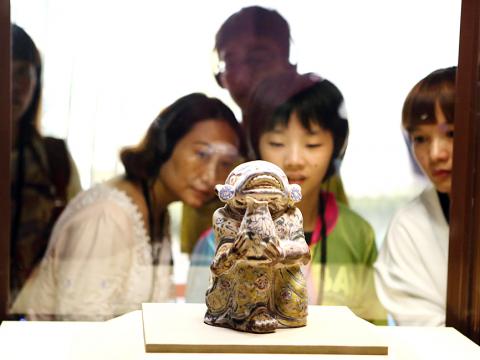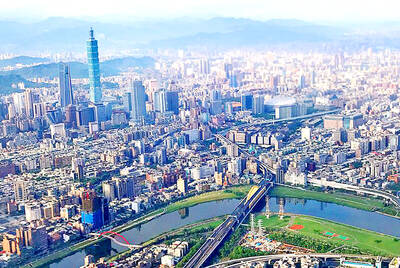The National Palace Museum (NPM) will allow visitors to photograph certain artifacts — including the Jadeite Cabbage and Meat-shaped Stone — from Sept. 1, reversing a long-standing police of prohibiting photography in the museum.
Photography has been banned to protect the artifacts, but during a three-month period from Sept. 1 to Dec. 1, photography and filming of utensil and implement-type artifacts will be allowed.
“So far the items that can be photographed or filmed under the new policy include metal vessels, jade and porcelain objects and other types of implements,” said Huang Hsuan-cheng (黃宣政), who is in charge of security at the museum.

Photo: Chen Yi-kuan, Taipei Times
“Aside from the popular Jadeite Cabbage and the Meat-shaped Stone, visitors will be able to have their pictures taken with the San Family Plate,” Huang said. “As for paintings and calligraphy works, we will have to wait for research to be completed to see which items the museum will allow visitors to photograph.”
Huang said the move is in line with a global trend of museums increasingly allowing photography of artifacts, citing the Louvre and the British Museum as examples.
Huang added that on Fridays and Saturdays when the museum is open until 9pm instead of the regular 6:30pm, photography will be prohibited from 6:30pm to 9pm to allow visitors to quietly enjoy the collections.
The museum said signs will be posted in areas where photography will remain prohibited. Tripods, flashes, external lights and selfie sticks will continue to be banned at all times.
The museum said it hopes those taking pictures will respect the flow of traffic around exhibits and will not affect other visitors’ enjoyment of the exhibits.
Group photography of more than nine people will not be allowed and people blocking pathways will be ushered on by museum staff, Huang said.

The Sports Administration yesterday demanded an apology from the national table tennis association for barring 17-year-old Yeh Yi-tian (葉伊恬) from competing in the upcoming World Table Tennis (WTT) United States Smash tournament in Las Vegas this July. The sports agency said in a statement that the Chinese Taipei Table Tennis Association (CTTTA) must explain to the public why it withdrew Yeh from the WTT tournament in Las Vegas. The sports agency said it contacted the association to express its disapproval of the decision-making process after receiving a complaint from Yeh’s coach, Chuang

The Hualien Branch of the High Court today sentenced the main suspect in the 2021 fatal derailment of the Taroko Express to 12 years and six months in jail in the second trial of the suspect for his role in Taiwan’s deadliest train crash. Lee Yi-hsiang (李義祥), the driver of a crane truck that fell onto the tracks and which the the Taiwan Railways Administration's (TRA) train crashed into in an accident that killed 49 people and injured 200, was sentenced to seven years and 10 months in the first trial by the Hualien District Court in 2022. Hoa Van Hao, a

Control Yuan Secretary-General Lee Chun-yi (李俊俋) tendered his resignation last night, admitting that he had misused a government vehicle, as reported by media. His resignation was immediately accepted by the Control Yuan. In a statement explaining why he had resigned, Lee apologized for using a Control Yuan vehicle to transport his dog to a pet grooming salon on May 20. The issue first came to light late last month, when TVBS News reported that Lee had instructed his driver to take the dog to the salon. The news channel broadcast photos that it said were taken by an unnamed whistle-blower, which purportedly showed the

Taipei has once again made it to the top 100 in Oxford Economics’ Global Cities Index 2025 report, moving up five places from last year to 60. The annual index, which was published last month, evaluated 1,000 of the most populated metropolises based on five indices — economics, human capital, quality of life, environment and governance. New York maintained its top spot this year, placing first in the economics index thanks to the strength of its vibrant financial industry and economic stability. Taipei ranked 263rd in economics, 44th in human capital, 15th in quality of life, 284th for environment and 75th in governance,